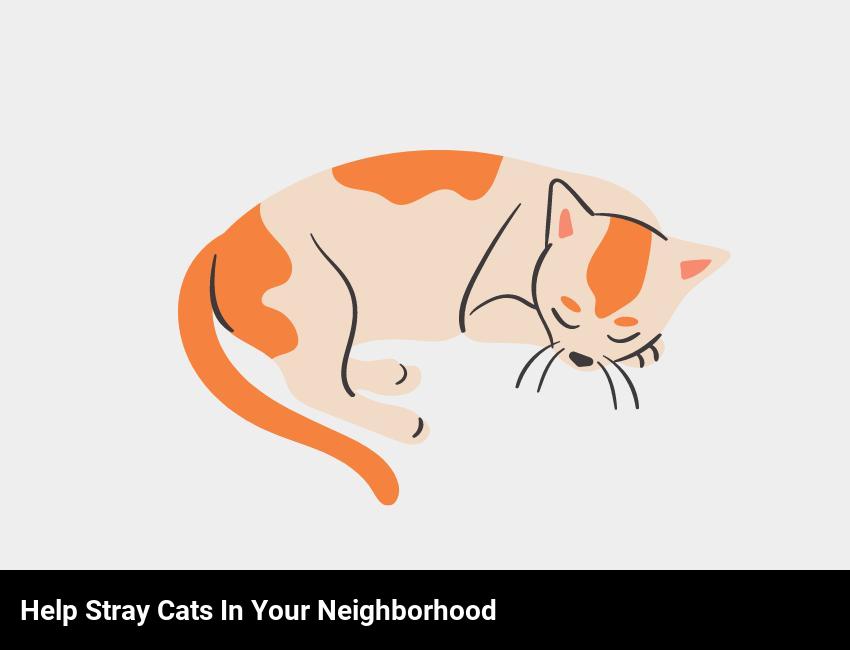How To Help Stray Cats In Your Neighborhood
If you are looking to help stray cats in your neighborhood, the best way is to contact your local animal shelter. They can provide advice on how to assess the cats, safely capture them if necessary, and find them loving homes.
I’ve always been passionate about animals and helping them however I can. When I moved into my new neighborhood, I noticed there were a lot of stray cats roaming around. I wanted to do something to help them, but I wasn’t sure how. I was worried about potential legal issues and didn’t know where to start. After doing some research, I discovered there are a lot of ways to help stray cats in your neighborhood.
Helping stray cats can be a rewarding and fulfilling experience. Not only are you providing a safe haven for these animals, but you are also helping to reduce the population of feral cats in your area. In this blog, I’ll be discussing the benefits of helping stray cats, different ways to help them, best practices for feeding and caring for them, and potential legal issues you should consider. I’ll also touch on how to educate people about the benefits of helping stray cats and some resources to help you get started. Finally, I’ll discuss some of the challenges you might face when helping stray cats in your neighborhood.
What are the different ways to help stray cats in your neighborhood?
If you’ve been wondering how you can help stray cats in your neighborhood, there are several options available to you. First, you can provide food and water to the cats. Leaving out food and water bowls in an easily accessible area can make a huge difference in the life of a stray cat. You can also keep the bowls full, so the cats have a consistent source of food and water.
Another way to help stray cats is by providing shelter. A simple outdoor shelter, such as a cardboard box or a plastic storage bin with a large opening, can help protect the cats from bad weather and predators. You can also consider building a small cat house that is insulated and waterproof, so the cats can stay warm and dry in any weather.
You can also help stray cats by getting them spayed or neutered. This will help reduce the number of stray cats in the neighborhood and help keep the cats healthier. If you’re not sure how to go about getting the cats spayed or neutered, you can contact a local animal shelter or veterinarian for help.
Finally, you can help stray cats by simply providing companionship and love. Spend some time each day petting and cuddling the cats, and provide them with toys and other items to keep them entertained. Even just a few minutes of your time can make a huge difference in the life of a stray cat.
These are just a few of the ways you can help stray cats in your neighborhood. With a bit of time and effort, you can make a huge impact and give these cats the care and attention they deserve.
What are the best practices for feeding and caring for stray cats?
Feeding and caring for stray cats is an important part of helping cats that don’t have a home. There are a few best practices you should keep in mind when feeding and caring for cats in your neighborhood.
First, always provide the cats with fresh food and clean water. You can buy small bags of dry cat food or cans of wet cat food from the store. If you’re able to, you can also make homemade meals for the cats. Make sure to provide food and water in clean bowls, and be sure to dispose of any leftover food.
Second, if you have the space, create a shelter for the cats. Set up a shelter in a quiet and sheltered area. You can use a large cardboard box or buy a plastic shelter from a pet supply store. Line the shelter with straw or blankets to keep the cats warm and comfortable.
Third, provide the cats with regular veterinary care. Take them to a veterinarian for regular checkups and vaccinations. This will ensure that the cats are healthy and safe.
Finally, be sure to spay or neuter the cats. This will help to reduce the homeless cat population and keep the cats healthy.
Following these best practices will help to make sure that the cats in your neighborhood are healthy and comfortable. Feeding and caring for stray cats is an important way to help cats in need.
What are the pros and cons of trap, neuter, and release programs?
If you’re looking for ways to help stray cats in your neighborhood, trap, neuter, and release (TNR) programs are an effective and humane way to reduce the number of cats in your area. But what are the pros and cons of this approach?
The biggest pro of TNR programs is that they decrease the number of cats in your neighborhood in a humane way. By spaying and neutering cats, you prevent them from reproducing and limit the number of cats in your area. You also reduce the amount of stress on individual cats who are competing for resources.
Another advantage of TNR programs is that cats can remain in their natural environment and are not taken to shelters or euthanized. This means that cats who would otherwise be killed can continue to live out their lives in the wild.
A disadvantage of TNR programs is that there is no guarantee that the cats won’t continue to reproduce. Even if all the cats in your neighborhood are spayed and neutered, new cats may move in and start reproducing. This means that the number of cats in your area could still increase.
Another downside of TNR programs is that cats may continue to cause problems for your neighborhood. Even if cats are spayed or neutered, they can still roam around and make noise or use your garden as a litter box.
Overall, TNR programs can be an effective way to help stray cats in your neighborhood. They reduce the number of cats, decrease competition for resources, and save cats from euthanasia. However, there are no guarantees that the number of cats won’t increase, and cats may still cause problems in your area.
What are the benefits of helping stray cats in your neighborhood?
Helping stray cats in your neighborhood is incredibly rewarding! Here are some of the main benefits of providing food and shelter to cats in need:
- Develop Compassion: As you get to know the stray cats in your area, you will start to develop a special bond and connection with them. This process can help you cultivate a sense of compassion, empathy, and understanding for animals in need.
- Reduce the Stray Population: By providing stray cats with food, shelter, and medical care, you can help reduce the population of stray cats in your neighborhood.
- Combat Animal Cruelty: By helping cats in your area, you are doing your part to combat animal cruelty. You can make sure that cats receive proper treatment and that they are not mistreated.
- Experience Joy: Caring for cats can bring you a lot of joy and happiness. When cats recognize you as their caregiver and come to you for food, shelter, and love, you will feel a very special kind of joy that comes from helping a creature in need.
- Get to Know Your Neighbors: Helping cats in your neighborhood can be a great way to get to know your neighbors. You can meet people who are also passionate about cats and animal welfare, and form meaningful connections.
How can you educate people about the benefits of helping stray cats?
You can educate people about the benefits of helping stray cats by talking to them about the issue, showing them stories of cats you have helped, or having them volunteer with you.
- Showing people the tangible benefits of helping stray cats can help them understand why it is important. For example, you can show them the positive impact it has had on a particular cat’s life.
- Explain to people why cats need our help and why it is important to take care of them. Make sure to emphasize the rewards we get from helping cats, such as the love and companionship of our feline friends.
- Invite people to volunteer with you at animal shelters or other organizations that help stray cats. This will make them feel part of the solution and help them understand the importance of the cause.
- Share stories of cats you have helped, such as how you took care of an injured cat and how it eventually recovered. These stories will help people understand the importance of taking care of cats and the impact it can have on their lives.
- Create educational materials, such as flyers or posters, that you can distribute to raise awareness about the issue.
- Finally, encourage people to take action and make a difference in the lives of cats by donating, adopting, or fostering cats. This will help people understand the importance of helping stray cats and what they can do to make a difference.
Are there any potential legal issues you should consider before you help stray cats?
Absolutely! Before you decide to help stray cats, there are a few legal issues to consider.
First and foremost, make sure you have permission to feed the cats from the property owner. Feeding cats without permission may conflict with local regulations and put you at risk of legal action. In addition, you should always be aware of any state or local animal control laws that may restrict how you interact with the cats.
You should also be aware of any local ordinances that may limit the number of cats you can feed or keep on the property. Feeding too many cats can cause an overload in the local ecosystem and attract other pests, so you should stay within the limits.
Finally, if you plan to trap, neuter, and release the cats, make sure you have permission from the local authorities to do so. This will ensure that you are not breaking any laws and that the cats are being cared for properly.
By considering the legal issues before you help stray cats, you can ensure that you are helping them in a safe and responsible way.
What are some resources to help you get started helping stray cats in your neighborhood?
If you’re looking for resources to help you get started helping stray cats in your neighborhood, you’ve come to the right place! There are many ways you can help cats in your area — from providing food and water to helping them find a home. The following are some great resources you can use to get started:
- Local Animal Shelters and Rescues – Animal shelters and rescues are a great place to start when it comes to helping stray cats in your neighborhood. They provide resources such as food, medical care, and adoption services, as well as other services such as spaying and neutering. You can contact your local animal shelter or rescue to see if they need volunteers or supplies.
- Fostering – Fostering is another great way to help cats in your area. Fostering is when you take in a stray cat and provide it with food and shelter until it can be placed in a permanent home. You can contact your local animal shelter or rescue to find out if they need foster parents.
- Trap-Neuter-Return – Trap-Neuter-Return (TNR) is a program that helps reduce the number of cats in a given area. The program involves trapping stray cats, getting them spayed or neutered, and then returning them to their original area. TNR is a great way to reduce the number of cats in your neighborhood and help them stay healthy.
- Social Media – Social media is an excellent way to spread the word about stray cats in your area. You can post photos and stories of cats you’ve helped or let people know about a TNR program in your area. There are also many Facebook groups dedicated to helping cats in need.
These are just a few of the many resources available to help you get started helping stray cats in your neighborhood. With a little bit of time and effort, you can make a difference in the lives of cats in your area.
What are some of the challenges you might face when helping stray cats in your neighborhood?
When you decide to help stray cats in your neighborhood, you are taking on a great responsibility and showing true kindness. But there are some challenges that you should be aware of.
One of the biggest challenges you may face is dealing with feral cats. These cats are usually born in the wild and are very difficult to tame. If you are not careful, feral cats can be dangerous and difficult to deal with.
You might also face resistance from your neighbors when trying to help stray cats in your neighborhood. People might be concerned that the cats will bring disease, damage property, or cause other problems. You will need to be patient when explaining to your neighbors why it is important to help the cats.
Another challenge you may face is finding reliable help. You will need to find people who are willing to donate money or supplies, or to volunteer their time. You will also need to make sure they are reliable and responsible before letting them help with the cats.
Finally, you may find that the neighborhood cats become conditioned to rely on you for food, water, and shelter. This can be a difficult situation to manage, as the cats may become overly dependent on you. As much as you want to help, it is important to make sure that the cats can still survive on their own in the wild.
Helping stray cats in your neighborhood requires a lot of patience and care, but it can be very rewarding. Just be aware of the challenges you may face and be prepared to handle them. With a little bit of effort, you can make a big difference for the cats in your community.

Frequently Asked Questions
How can i safely interact with stray cats in my neighborhood?
Interacting with stray cats in your neighborhood can be done safely by taking a few precautions. Make sure to keep a safe distance from the cat, and avoid quick movements. Gently offer a friendly hand to let the cat sniff it. If the cat is comfortable, you can slowly and gently pet the cat. Avoid making loud noises, and never try to pick up the cat without its permission.
How can i tell if a stray cat is sick or injured?
If you spot a stray cat in your neighborhood, you should look for signs of illness or injury. Look for signs such as limping, runny eyes and nose, coughing, weak or depressed behavior, or any open wounds. If you spot any of these signs, the cat may require medical attention and you should contact a local animal shelter or vet for help.
Are there any legal considerations for caring for stray cats?
Yes, there are legal considerations for caring for stray cats. Depending on the laws in your area, you may need to obtain permits or licenses to provide food and shelter for strays. Additionally, you may need to pay a fee to trap, spay/neuter, and release cats or to find homes for them. Check with your local shelter or animal control to learn more about the laws in your area.
What can i do to help the stray cats in my community find homes?
You can help stray cats in your neighborhood by providing them with food and water, trapping and neutering them, and finding them loving homes. Start by setting up a feeding station for the cats in your area. You can also contact your local animal shelter to help you trap and neuter the cats. Finally, use online resources to find loving homes for the cats you help.
What are the most important things i should do to ensure the safety of stray cats in my area?
To ensure the safety of stray cats in your area, the most important thing to do is to provide them with food and water. Make sure to set out food and water dishes in a secure area, away from predators. Additionally, provide some shelter for them, such as a plastic bin, an old blanket, or a simple lean-to. If possible, have them spayed or neutered and vaccinated to prevent the spread of disease. Finally, monitor the cats and take note of any changes in behavior that could signal an underlying health issue.







